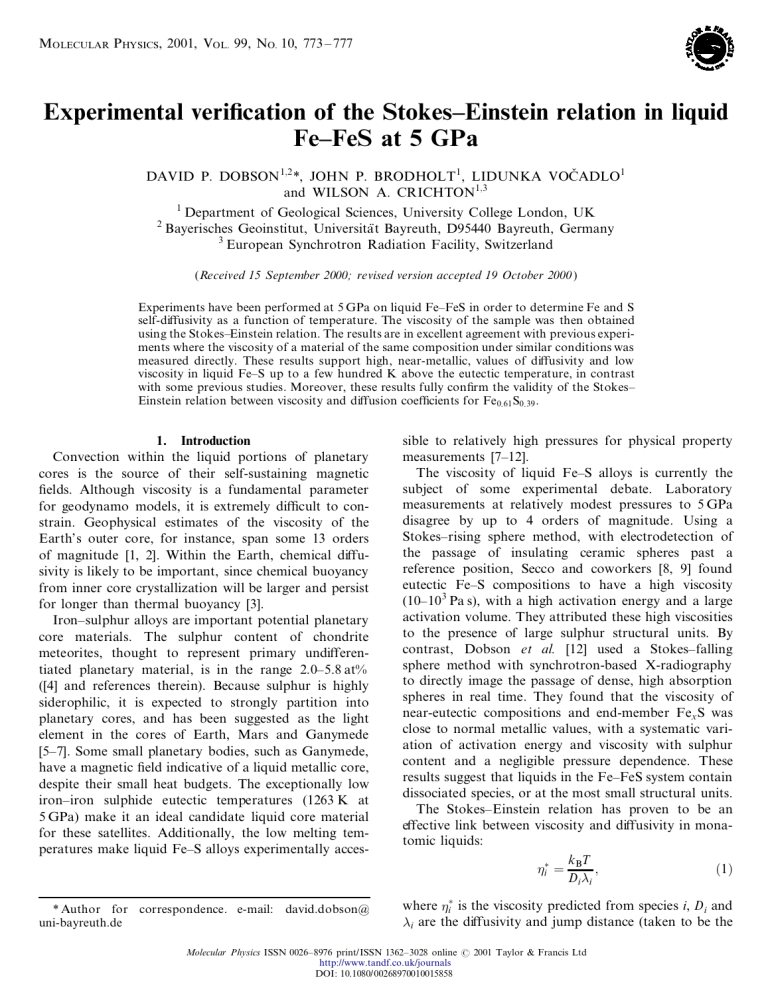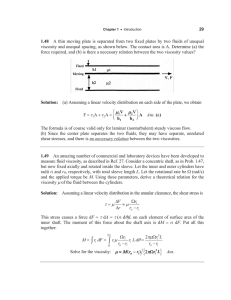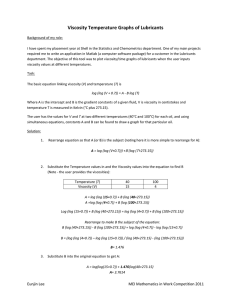Experimental veri® cation of the Stokes± Einstein relation in liquid
advertisement

MOLECULAR P HYSICS, 2001, VOL. 99, NO. 10, 773 ± 777 Experimental veri® cation of the Stokes± Einstein relation in liquid Fe± FeS at 5 GPa DAVID P. DOBSON 1;2 *, JOHN P. BRODHOLT1 , LIDUNKA VOCÏADLO1 and WILSON A. CRICHTON1;3 1 2 Department of Geological Sciences, University College London, UK Bayerisches Geoinstitut, UniversitaÈ t Bayreuth, D95440 Bayreuth, Germany 3 European Synchrotron Radiation Facility, Switzerland (Received 15 September 2000; revised version accepted 19 October 2000) Experiments have been performed at 5 GPa on liquid Fe± FeS in order to determine Fe and S self-diŒusivity as a function of temperature. The viscosity of the sample was then obtained using the Stokes± Einstein relation. The results are in excellent agreement with previous experiments where the viscosity of a material of the same composition under similar conditions was measured directly. These results support high, near-metallic, values of diŒusivity and low viscosity in liquid Fe± S up to a few hundred K above the eutectic temperature, in contrast with some previous studies. Moreover, these results fully con® rm the validity of the Stokes± Einstein relation between viscosity and diŒusion coe cients for Fe 0:61 S0:39 . 1. Introduction Convection within the liquid portions of planetary cores is the source of their self-sustaining magnetic ® elds. Although viscosity is a fundamental parameter for geodynamo models, it is extremely di cult to constrain. Geophysical estimates of the viscosity of the Earth’ s outer core, for instance, span some 13 orders of magnitude [1, 2]. Within the Earth, chemical diŒusivity is likely to be important, since chemical buoyancy from inner core crystallization will be larger and persist for longer than thermal buoyancy [3]. Iron± sulphur alloys are important potential planetary core materials. The sulphur content of chondrite meteorites, thought to represent primary undiŒerentiated planetary material, is in the range 2.0± 5.8 at% ([4] and references therein). Because sulphur is highly siderophilic, it is expected to strongly partition into planetary cores, and has been suggested as the light element in the cores of Earth, Mars and Ganymede [5± 7]. Some small planetary bodies, such as Ganymede, have a magnetic ® eld indicative of a liquid metallic core, despite their small heat budgets. The exceptionally low iron± iron sulphide eutectic temperatures (1263 K at 5 GPa) make it an ideal candidate liquid core material for these satellites. Additionally, the low melting temperatures make liquid Fe± S alloys experimentally acces- * Author for correspondence. e-mail: david.dobson@ uni-bayreuth.de sible to relatively high pressures for physical property measurements [7± 12]. The viscosity of liquid Fe± S alloys is currently the subject of some experimental debate. Laboratory measurements at relatively modest pressures to 5 GPa disagree by up to 4 orders of magnitude. Using a Stokes± rising sphere method, with electrodetection of the passage of insulating ceramic spheres past a reference position, Secco and coworkers [8, 9] found eutectic Fe± S compositions to have a high viscosity (10± 103 Pa s), with a high activation energy and a large activation volume. They attributed these high viscosities to the presence of large sulphur structural units. By contrast, Dobson et al. [12] used a Stokes± falling sphere method with synchrotron-based X-radiography to directly image the passage of dense, high absorption spheres in real time. They found that the viscosity of near-eutectic compositions and end-member Fex S was close to normal metallic values, with a systematic variation of activation energy and viscosity with sulphur content and a negligible pressure dependence. These results suggest that liquids in the Fe± FeS system contain dissociated species, or at the most small structural units. The Stokes± Einstein relation has proven to be an eŒective link between viscosity and diŒusivity in monatomic liquids: k T …1† ²i¤ ˆ B ; Di ¶i where ²i¤ is the viscosity predicted from species i, Di and ¶i are the diŒusivity and jump distance (taken to be the Molecular Physics ISSN 0026± 8976 print/ISSN 1362± 3028 online # 2001 Taylor & Francis Ltd http://www.tandf.co.uk/journals DOI: 10.1080/00268970010015858 774 D. P. Dobson et al. interatomic distance) of species i, T is absolute temperature and kB is the Boltzmann constant. Dissociated liquid metals and liquid salts all closely obey the Stokes± Einstein relation [1], as do the monatomic ionic components of polymerized silicate melts [13]. Large structural units, however, such as liquid Se4 and the polymerized components of liquid silicates do not obey the relationship. The Stokes± Einstein relation is therefore a strong test for polymerization in liquids. We present results here of iron and sulphur self-diŒusion measurements in liquid Fe± S eutectic at 5 GPa. Using atomic bond-lengths derived from simulations results we relate the diŒusivity to viscosity measurements via the Stokes± Einstein relation, and ® nd these data to be entirely consistent with recent viscosity measurements [12, 14]. 2. Experimental 2.1. Materials and methods High pressure tracer diŒusion experiments were performed in a Walker-type multi-anvil press at UCL using the technique described in [11]. Details of high pressure techniques are given elsewhere [15, 16]. Samples of Fe0:61 S0:39 were prepared as follows. Powders of Fe and FeS were ground together under acetone in eutectic proportions. 34 S enriched FeS was prepared from a stoichiometric mixture of Fe and S by fusion at 2 GPa and 1050 8C. The recovered sample was found to be entirely pyrrhotite (Fe7 S8 ) by powder X-ray diŒraction. Thin (40 mm) discs of Fe0:61 S0:39 , enriched in 34 S and 57 Fe, were prepared and placed on the end of 2± 3 mm long cylinders with natural isotopic abundances. The whole was then compacted in a pellet press under a 0.5 ton load to produce a solid cylinder of 0.8 mm diameter and 2 mm length, which was loaded into the capsule. Double encapsulation, with inner Al2 O3 and outer Fe capsules, was used to chemically isolate the sample and, in particular, minimize oxygen contamination. The ® lled capsule was placed centrally in a horizontal cylindrical graphite furnace, but just above the furnace axis. This ensured that the sample experienced a gravitationally stable thermal gradient, inhibiting convection. Experiments were performed by compressing the sample to 5 GPa at room temperature. The sample was then heated at a rate of 300 K min¡1 to the experimental temperature, upon which power was cut to the furnace, resulting in quench rates in excess of 500 K s¡1 . 2.2. Analytical Polished sections of recovered samples were analysed by electron microprobe for oxygen content and by secondary ion mass spectrometry (SIMS) for 57 Fe, 54 Fe, 32 S and 34 S. Electron probe standards consisted of pure Fe, FeS2 pyrite and fayalite for Fe, S and O, respectively, with an accelerating voltage of 15 kV. Quench textures were averaged by rastering the 1 mm beam over an area of 300 mm 2 . SIMS analyses were performed under the following conditions: a 20 mA O¡ primary beam was used with secondary acceleration of 5 kV. Burns of 60 s were followed by 5 s collecting on each mass. Relative ion yield for the tracer ions was obtained from the ratios of 57 Fe to 54 Fe and of 34 S to 32 S. The mass resolving power in the low mass resolution mode was 2000 for 32 S, which was su cient to resolve between 32 S and 16 O2 interferences using a 100 V oŒset on the secondary accelerating voltage. 3. Results Figure 1 shows measured 57 Fe and 34 S diŒusion pro® les for one experiment and the pro® le ® tted according to the tracer equation [17] C=C0 ˆ exp ¡…x2 =4Z†; …2† where C is the concentration a distance x from x0 , C0 is the concentration at x0 , and Z is the diŒusivity D integrated over time t: …t Z ˆ D…t† dt: …3† 0 The small positive errors for low x arise from the ® nite thickness of the `tracer’ source and are negligible for values of x more than 10 times the tracer thickness. This small deviation from true tracer behaviour has negligible eŒect on the calculated diŒusivities. For longer durations, the pro® le re¯ ects at the sample ends, which act as impermeable boundaries; this is treated in the normal way [11]. In experiments where heating is a negligible proportion of the duration, D is constant, Z ˆ Dt and equation (2) becomes the standard tracer equation. However, because diŒusion in these experiments occurred during increasing temperature, the diŒusivity varied with time. Samples quenched from diŒerent temperatures during constant heating rate experiments sample diŒerent values of Z, everything else being constant. Experimentally determined values of Z were integrated assuming an Arrhenius dependence of D on temperature: ³ ´ ¡QD D ˆ D0 exp …4† ; RT where T is a linear function of t, to give values of D at each experimental temperature. The preexponential D0 and apparent activation energy QD were treated as parameters for ® tting, and errors were minimized by an iterative least-squares process. Measured Fe and S selfdiŒusion coe cients at 5 GPa and high temperature are presented in table 1. 775 Stokes± Einstein viscosity± diVusion relation for Fe± FeS Figure 1. Concentration pro® les of tracer isotopes 57 Fe (circles) and 34 S (squares) for one experiment on liquid Fe0:61 S0:39 at 5 GPa. Lines are the ® ts to the data. Lower lines show the ® tting errors. Table 1. T/K 1293 1423 1473 QD /kJ mol¡1 D0 cm2 s¡1 a Measured Fe and S self-diŒusivities and Arrhenius parameters for liquid Fe 0:61 S0:39 .a ZFe/mm2 DFe /cm2 s¡1 ZS /mm2 DS /cm2 s¡1 0:95 § 0:04 £ 10¡1 1:88 § 0:04 £ 10¡1 2:91 § 0:04 £ 10¡1 1:05 § 0:1 £ 10¡5 2:29 § 0:01 £ 10¡5 2:97 § 0:01 £ 10¡5 91 § 4 5:20 § 0:10 £ 10¡2 0:77 § 0:03 £ 10¡1 1:29 § 0:03 £ 10¡1 2:17 § 0:08 £ 10¡1 0:80 § 0:1 £ 10¡5 1:64 § 0:1 £ 10¡5 2:09 § 0:05 £ 10¡5 84 § 10 1:98 § 0:14 £ 10¡2 Errors quoted are one standard error. 4. Stokes± Einstein treatment VocÏadlo et al. [18] performed ab inito simulations of Fe± FeS eutectic melt at 5 GPa and 1300 K and 1500 K. Their Fe± S partial radial distribution function (PRDF) Ê ) is consistent with the ® rst peak at 1500 K (¹2.2 A experimental value for Fex S at 5 GPa and 1873 K (2.35 AÊ ) [10]. Using the ® rst peaks of the Fe± Fe PRDF and S± S PRDF from [18] for ¶Fe and ¶S , respectively, and diŒusion values from table 1 in equation (1), two independent estimates of viscosity are obtained for the Fe and S species. The predicted viscosities are given in table 2 and compared with previously determined values for the same composition in ® gure 2. The predicted viscosities from sulphur and iron diŒusivities are indistinguishable and the data agree with measured viscosities within two standard errors. 5. Discussion The accuracy of the Stokes± Einstein relation for liquid Fe0:61 S0:39 suggests that this is a strongly dissociated liquid, consistent with previous structural studies [10] and ab initio simulation results [18]. Furthermore, ¤ the excellent agreement between ²Fe and ²S¤ strongly implies that large sulphur structural units are not aŒecting melt properties; indeed the diŒerence between 776 D. P. Dobson et al. Figure 2. Predicted viscosity ²i¤ for Fe and S selfdiŒusion (solid circles and squares), using simulated atomic sizes from VocÏadlo et al. (2000), and measured viscosity (open circles) (Dobson et al. 2000). Errors are one standard error for ²i¤ and upper and lower error bounds for measured viscosity; solid lines represent the viscosity range extrapolated from the measured values. The predicted and measured values are consistent at a 95% con® dence level. Table 2. Measured and predicted viscosity in liquid Fe 0:61 S0:39 .a T /K ²¤Fe /Pa s ²S¤ /Pa s ²meas/Pa s 1293 1423 1473 1563 1647 0:067 § 0:009 0:034 § 0:003 0:027 § 0:003 0:066 § 0:013 0:036 § 0:004 0:029 § 0:003 0:024 § 0:004 a ²¤Fe , ²S¤ 0:012 § 0:002 0:0075 § 0:002 and ²meas are the predicted viscosities from Fe and S diŒusivity, and the directly measured viscosity from [12], respectively. DS and DFe can be attributed entirely to the diŒerence in atomic size between the two species. Eyring’ s activated state theory of liquids [19] relates viscosity to diŒusivity via an equation of Stokes± Einstein form. Additionally, it predicts that, along the melting path, viscosity should be independent of pressure. As noted in [1], such homologous behaviour would be highly useful for geophysicists since the melting temperature viscosity at ambient pressure would be equal to the viscosity at the solid inner-liquid outer core boundary. We have previously [12] tested the homologous behaviour of an Fe0:83 S0:17 liquid and ® nd this assumption to be consistent with low pressure experimental and simulation results, and simulation results at 330 GPa, the pressure of the outer± inner core boundary [20]. The present results imply that it would, in principle, be possible to estimate chemical diŒusivity of liquid planetary cores from geophysical estimates of viscosity and density. The large scatter in geophysically determined outer core viscosity suggests, however, that many of these measurements sample the eddy viscosity, which can be many times larger than the molecular viscosity and therefore are not appropriate for such a treatment. D.P.D. acknowledges his NERC research fellowship; J.P.B. and L.V. acknowledge their Royal Society URFs. W.A.C. contributed to this study as part of a NERC funded PhD. The Edinburgh ion microprobe is an NERC supported facility. References [1] Poirier, J. P., 1988, Geophys. J., 92, 99. [2] Secco, R. A., 1995, Handbook of Physical Constants, AGU reference shelf 2, edited by T. J. Ahrens (Washington, DC: American Geophysical Union) p. 218. [3] Loper, D. E., and Roberts, P. H., 1981, Phys. Earth Planet. Inter., 24, 302. [4] Newson, H. E., 1995, Global Earth Physics: A Handbook of Physical Constants, edited by T. J. Ahrens (Washington, DC: American Geophysical Union) p. 159. [5] Morgan, J., and Anders, W. E., 1980, Proc. Natl. Acad. Sci., 77, 6973. [6] Wanke, H., and Dreibus, G., 1988, Phil. Trans. R. Soc. A, 325, 545. [7] Sanloup, C., Guyot, F., Gillet, P., Mezouar, M., and Martinez, I., 2000, Geophys. Res. Lett., 27, 811. [8] LeBlanc, G. E., and Secco, R. A., 1996, Geophys. Res. Lett., 23, 213. [9] Secco, R. A., LeBlanc, G. E., Yang, H., and Siebel, J. N., 1998, Properties of Earth and Planetary Materials at High Pressure and Temperature, edited by M. H. Stokes± Einstein viscosity± diVusion relation for Fe± FeS [10] [11] [12] [13] Manghnani and T. Yagi (Washington, DC: American Geophysical Union) p. 495. Urakawa, S., Igawa, N., Kusaba, K., Ohno, H., and Shimomura, O., 1998, Rev. High Press. Sci. Technol., 7, 286. Dobson, D. P., 2000, Phys. Earth Planet. Inter., 120, 137. Dobson, D. P., Crichton, W. A., VoCÏadlo, L., Jones, A. P., Wang, Y., Uchida, T., Rivers, M., Sutton, S., and Brodholt, J. P., 2000, Amer. Mineralogist, 85, 1838. Poe, B. T., McMillan, P. F., Rubie, D. C., Chakraborty, S., Yarger, J., and Diefenbacher, J., 1997, Science, 276, 1245. 777 [14] Urakawa, S., Terasaki, H., Funakoshi, K., Kato, T., and Suzuki, A., 2000, Amer. Mineralogist, in press. [15] Walker, D., Carpenter, M. A., and Hitch, C. M., 1990, Amer. Mineralogist, 75, 1020. [16] Taniguchi, T., Dobson, D. P., Rabe, R., and Jones, A. P., 1996, High Temp. High Press., 27/ 28, 365. [17] Crank, J., 1975, The Mathematics of DiVusion, 2nd Edn (Oxford: Clarendon Press). [18] Vo CÏadlo, L., AlfEÁ, D., Price, G. D., and Gillan, M. J., 2000, Phys. Earth Planet. Inter., 120, 145. [19] Eyring, H., 1936, J. chem. Phys., 4, 283. [20] AlfEÁ, D., and Gillan, M. J., 1998, Phys. Rev. B, 58, 8248.



